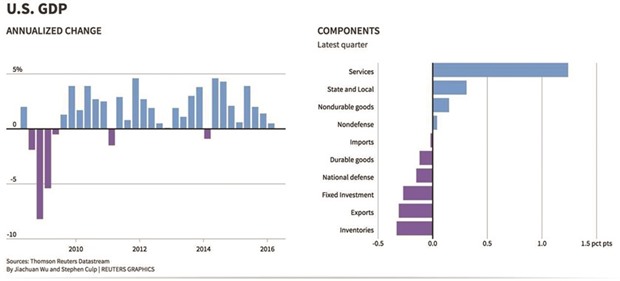Gross domestic product increased at a 2.9% annual rate after rising at a 1.4% pace in the second quarter, the Commerce Department said yesterday in its first estimate.
That was the strongest growth rate since the third quarter of 2014 and beat economists’ expectations for a 2.5% expansion pace.
Business investment improved last quarter, though spending on equipment remained weak.
Despite the moderation in consumer spending, the third-quarter rise in growth could help dispel any lingering fears the economy was at risk of stalling.
Over the first half of the year, growth had averaged just 1.1%.
“This shows that the US is roughly on track. It’s a natural bounce back following a pretty underwhelming year so far,” said Luke Bartholomew, fixed income investment manager at Aberdeen Asset Management in London. “The election campaign has probably created a degree of uncertainty that has impacted growth.” Americans go to the polls on November 8.
Though the Federal Reserve is mostly focused on employment and inflation, signs of economic strength would be supportive of an interest rate hike in December.
The US central bank raised its benchmark overnight interest rate last December for the first time in nearly a decade.
The dollar rose to a three-month high against the yen on the report, while prices for US government bonds fell.
US stock index futures were little changed.
Consumer spending still supported the economy in the third quarter, even as the pace slowed from the second quarter’s robust 4.3% rate.
Consumer spending, which accounts for more than two-thirds of US economic activity, increased at a 2.1% rate.
Spending was held back by a decline in purchases of goods which are not meant to last long.
With a tightening labour market generating a steady increases in wages and strong household balance sheets, spending could accelerate in the fourth quarter.
Data on Friday from the Labor Department showed labour costs rose 0.6% in the third quarter after a similar gain in the second quarter, leaving the year-on-year rate of increase at 2.3%.
A surge in soybean exports helped to shrink the trade deficit in the third quarter.
Exports increased at a 10% rate, the biggest rise since the fourth quarter of 2013.
As a result, trade contributed 0.83 percentage point to GDP growth after adding a mere 0.18 percentage point in the April-June quarter.
There are concerns that the soybean-driven export growth spurt could reverse in the fourth quarter.
Economists, however, also note that exports of capital and consumer goods have been growing strongly in recent months.
Businesses increased spending to restock after running down inventories in the second quarter.
Businesses accumulated inventories at a $12.6bn rate in the last quarter, contributing 0.61 percentage point to GDP growth.
Spending on nonresidential structures, which include oil and gas wells, increased at a 5.4% rate in the third quarter, the fastest pace since the second quarter of 2014, after falling at a 2.1% pace in the second quarter.
Business spending on equipment slipped at a 2.7% rate, dropping for a fourth straight quarter.
While the pace of decline has been ebbing as oil prices stabilise and the dollar’s rally gradually fades, a strong turnaround is unlikely in the near-term.
Heavy machinery maker Caterpillar this week reported a 49% drop in third-quarter profit from a year ago and lowered its full-year revenue outlook for the second time this year.
Caterpillar said demand for new heavy machinery had been undercut by an “abundance” of used construction equipment, a “substantial” number of idle locomotives and a “significant” number of idle mining trucks.
Investment in residential construction fell for a second straight quarter, while spending by the government bounced back.

